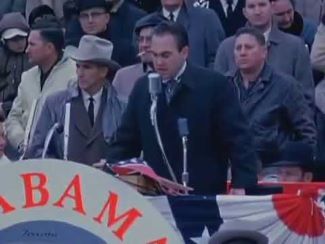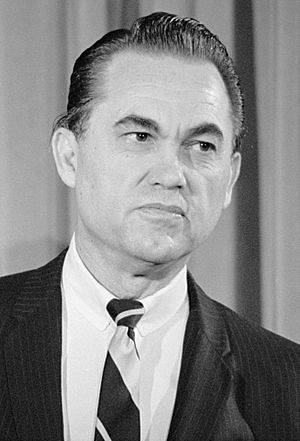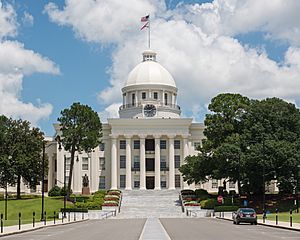George Wallace's 1963 Inaugural Address facts for kids
Quick facts for kids George Wallace's Inaugural Address |
|
|---|---|
| Part of the Civil Rights Movement | |
 |
|
| Date | January 14, 1963 |
| Location | |
George Wallace's 1963 Inaugural Address was a famous speech given on January 14, 1963. This was after he was elected as the governor of Alabama. At this time, Wallace strongly supported racial segregation. This meant keeping Black and white people separate in public places. As governor, he tried to stop the United States government from ending segregation in Alabama's schools and other areas.
The speech is most known for a powerful phrase: "segregation now, segregation tomorrow, segregation forever." This phrase became a popular saying for people who were against integration. It also became a rallying cry for those who opposed the Civil Rights Movement.
Contents
Why the Speech Happened
Before becoming governor, George Wallace was a judge and a state lawmaker in Alabama. In his early career, he was seen as more moderate on racial issues. This means he was not as extreme as some others. He was even supported by groups like the NAACP. The NAACP worked for equal rights for Black Americans.
However, the Civil Rights Movement was growing. Events like the Montgomery Bus Boycott made many white Alabamians feel worried. They felt their way of life was being threatened. In 1958, Wallace lost his first try for governor. His opponent, John Patterson, openly supported segregation and won easily.
After this loss, Wallace decided he needed to change his views on race to win. He realized that supporting segregation was popular with voters in Alabama.
Wallace's Campaign and His Famous Speech
Wallace's new strong stance on racial issues became clear in 1959. He was the only judge who at first refused to give voting records to a federal group. This group was looking into unfair treatment of Black voters. Even though he eventually gave in, his actions made him known for standing up to the federal government.
During his 1962 campaign for governor, Wallace spoke against integration. He claimed it caused problems like crime and job losses. He even hired a speechwriter named Asa Carter. Carter was known for his strong views and helped Wallace create a very powerful way of speaking. Wallace's message of fighting integration was very popular. He won the election with more votes than any previous Alabama governor.
After winning, Wallace wanted to show he would keep his promises. Asa Carter wrote the inaugural address. On January 14, 1963, Wallace gave the speech. He stood on the steps of the Alabama State Capitol. This was the same spot where Jefferson Davis had become president of the Confederate States of America. This was a very meaningful choice of location.
In his speech, Wallace famously declared:
In the name of the greatest people that have ever trod this earth, I draw the line in the dust and toss the gauntlet before the feet of tyranny, and I say segregation now, segregation tomorrow, segregation forever.
Both Wallace and Carter knew this phrase would be remembered. Wallace used the word "tyranny" to describe the federal government. He felt the government was unfairly forcing integration on Alabama. He argued that the federal government was taking away the rights of Alabamians. He said that states should have the right to decide on segregation.
Wallace also argued that racial differences were like choosing a political party or religion. He claimed people had "racial or cultural freedom." This meant they had the right to live in a segregated society.
How People Reacted
Wallace's strong words made his supporters in Alabama happy. The speech also made national news. Major newspapers and magazines like The New York Times and Time covered it. Wallace became very well known. Later that year, he even announced he would run for U.S. President.
However, many people did not like Wallace's speech. Civil rights supporters were very critical. Some people in Alabama also worried. They thought fighting the federal government would only hurt the state. Business leaders were concerned that Alabama was getting a bad reputation. They feared it would be seen as a place of "rebellion" and "bigotry."
Many who wanted to end segregation saw Wallace's speech as racist. Civil rights leader John Lewis said his heart sank when he heard it. He knew Wallace's talk of "states' rights" was really about keeping segregation. Later, protesters in Alabama chanted against Wallace. They sang, "Ol' Wallace, you never can jail us all. Ol' Wallace, segregation is bound to fall."
Martin Luther King Jr. also spoke out against Wallace's address. In early 1963, he traveled to many cities. He spoke about the need to fight against unfair segregation. Later that year, King gave his famous I Have a Dream speech. In it, he spoke about Alabama's "vicious racists" and its governor. He dreamed that one day, Black and white children in Alabama would be able to join hands.
King's hopeful vision was very different from Wallace's demand to keep segregation. King believed segregation was old-fashioned and would not last. In 1965, King gave another speech in Alabama. He said that "segregation is on its death bed in Alabama." He believed it was only a matter of time before it ended.
What We Remember Today
Journalist Bob Ingram said that Wallace liked the "segregation now, segregation tomorrow, segregation forever" line when he first saw it. However, later in his life, Wallace changed his mind about segregation. He came to regret his famous phrase. He called it his "biggest mistake."
Wallace later claimed he didn't mean to say those words. He said he was cold and just read them without thinking. But many people believe his speech helped create a difficult time. It led to violence against those who wanted to end racial discrimination. Wallace's strong support for segregation became his most remembered political moment. It showed how much opposition the Civil Rights Movement faced.



